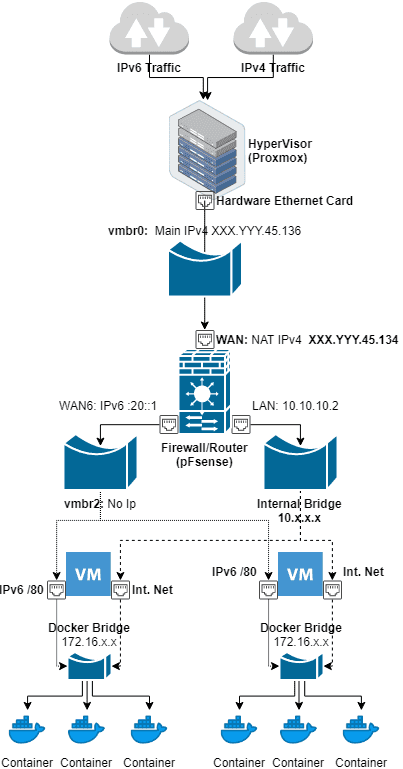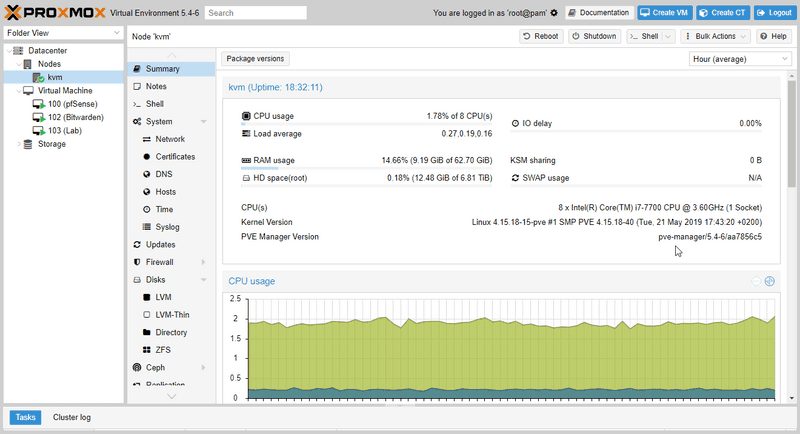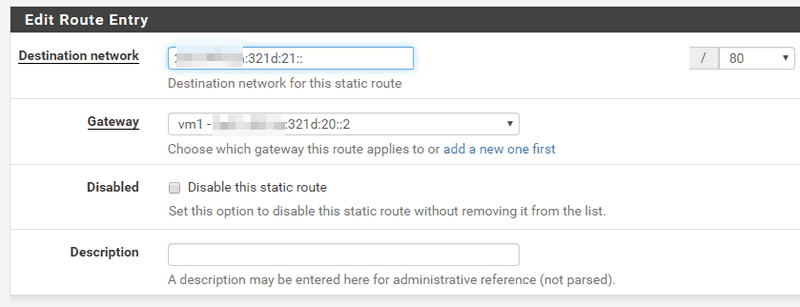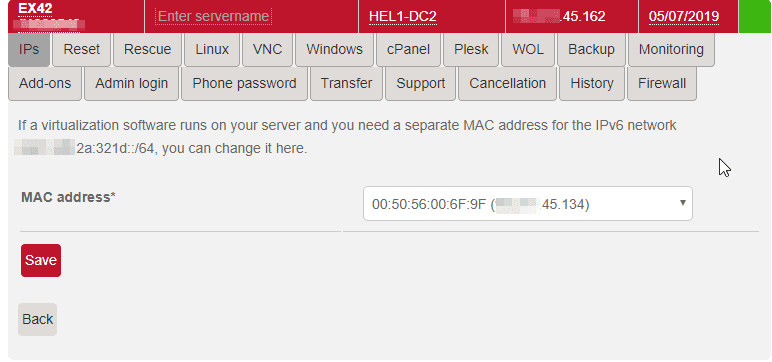Introduction
This tutorial will help you setup Docker with IPv6 in a secure way.
Objectives
- Automatic provisioning of IPv6
- Each Docker container will receive an IPv6 automatically
- Routed IPv6 traffic between container in different Hosts
- Each host will have a /80 that will be routed through pfSense
- Secured public access to our containers via IPv6
- They will be reachable publicly so we want to be able to whitelist open ports in a secure way
- Out of band Firewall
- Having an out of band firewall, meaning outside of the VM, will increase the security of the system
Requirements
- IPv6 network
For this article, we will use a /64 IPv6 network because that is what many hosting providers give, and we will use the example 2001:db8:1234:321d::1/64. This will be divided in 4096 /76s:
- 2001:db8:1234:321d:10::1/76 WAN in Pfsense
- 2001:db8:1234:321d:20::1/76 VIP (or WAN6) gateway for VM1
- 2001:db8:1234:321d:21::/80 for Docker containers in VM1
- 2001:db8:1234:321d:30:1/76 VIP gateway for VM2
- 2001:db8:1234:321d:31::1/80 for Docker containers in VM2
- 2001:db8:1234:321d:3e80::1/76 VMx
- 2001:db8:1234:321d:3e81::1/80 for Docker containers in VMx
- Hypervisor
We will need a way to provision VMs, for this article we selected Proxmox. More information on Proxmox can be found on their website: https://www.proxmox.com/en/proxmox-virtual-environment/get-started
There is already a Tutorial on how to install Proxmox remotely on any server: https://community.hetzner.com/tutorials/install-and-configure-proxmox_ve
Step 1 - Create Bridges
We will create 3 bridges:
- vmbr0: It will connect to the internet and receive both IPv4 and IPv6 traffic but will only have the main IPv4 assigned x.y.145.162/26
- vmbr1: The internal network shared between VMs, 10.10.10.1/24
- vmbr2: This bridge will hold the IPv6 network for our VMs, in this case a /64
Contents of /etc/network/interfaces (this is autogenerated by Proxmox):
auto lo
iface lo inet loopback
iface ens3 inet manual
iface eth0 inet manual
auto vmbr0
iface vmbr0 inet static
address x.y.145.162
netmask 26
gateway x.y.45.129
bridge-ports eth0
bridge-stp off
bridge-fd 0
auto vmbr1
iface vmbr1 inet static
address 10.10.10.1
netmask 24
bridge-ports none
bridge-stp off
bridge-fd 0
bridge-vlan-aware yes
bridge-vids 2-4094
auto vmbr2
iface vmbr2 inet manual
bridge-ports none
bridge-stp off
bridge-fd 0
Step 2 - Setup Firewall (pfSense)
We will need an out of band Firewall to be able to whitelist open ports and for this, we are going to use pfSense.
More information on using pfSense with Proxmox can be found here.
We will add 3 network cards and configure each one to one of the Bridges we created before.
Step 2.1 - Interface assignments
IPv4
- WAN NAT IPv4: x.y.145.136/26
- WAN NAT IPv6: 2001:db8:1234:321d:10::1/76
- LAN 10.10.10.2
We have 2 IPv4 assigned, one to access the Host KVM and the other to use as NAT and for the internal LAN.
IPv6 Default gateways for the VM hosts.
- WAN6 2001:db8:1234:321d:20::1
- VIP 2001:db8:1234:321d:30::1
- VIP 2001:db8:1234:321d:3e80::1
Step 2.2 - Routing
The default GW for IPv6 is fe80::1 through the WAN interface (not WAN6). This is because this interface is connected to the KVM bridge that has access to the connection to the internet.
Each Docker network in the VM host gets a static route so they can communicate between each other. For this we need to define a Gateway as 2001:db8:1234:321d:20::2 through the WAN6 interface called "vm1" in the picture.
Finally we add a static route saying that our container subnet 21::/80 can be reached through the "vm1" gateway, that means through the interface WAN6 via the host at 20::2.
Step 2.3 - MAC assignment for IPv6
Many hosters require that IPv6 traffic comes from the same MAC address associated with one of the IPv4. In this case it is the extra NAT IPv4.
Step 2.4 - Firewall Rules
We need to create the following firewall rules:
-
WAN:
- ANY to our IPv6 /80
- ANY to our IPv6/ports we want to be public
- From WAN6 to ANY (outgoing traffic)
-
WAN6:
- Protocol IPv6 to WAN6 (outgoing traffic)
Step 3 - VM configuration
In this example we use systemd-networkd but the same idea can be used on any network manager. Basic information on systemd-networkd can be found here: https://wiki.archlinux.org/index.php/Systemd-networkd
Notice we use ::2 for our VM IPv6 and WAN6 interface IP as a default route.
[Match]
Name=eth1
[Network]
Address=2001:db8:1234:321d:20::2/80
Gateway=2001:db8:1234:321d:20::1
[Route]
Gateway=2001:db8:1234:321d:20::1
This will give us:
# ip -6 addr show dev eth1
3: eth1: <BROADCAST,MULTICAST,UP,LOWER_UP> mtu 1500 qdisc fq_codel master docker0 state UP group default qlen 1000
inet6 2001:db8:1234:321d:20::2/76 scope global
valid_lft forever preferred_lft forever
inet6 fe80::e470:c4ff:fe34:1491/64 scope link
valid_lft forever preferred_lft forever
Test we have IPv6 connectivity:
# ping -6 www.google.com
PING www.google.com(ams16s29-in-x04.1e100.net (2a00:1450:400e:804::2004)) 56 data bytes
64 bytes from ams16s29-in-x04.1e100.net (2a00:1450:400e:804::2004): icmp_seq=1 ttl=55 time=32.2 ms
64 bytes from ams16s29-in-x04.1e100.net (2a00:1450:400e:804::2004): icmp_seq=2 ttl=55 time=32.5 ms
64 bytes from ams16s29-in-x04.1e100.net (2a00:1450:400e:804::2004): icmp_seq=3 ttl=55 time=32.4 msStep 4 - Docker configuration
Basic information on configuring a routed Docker environment with IPv6 can be found here: https://docs.docker.com/v17.09/engine/userguide/networking/default_network/ipv6/#routed-network-environment
We configure docker to use our /80 subnets under 21::/80.
# cat /etc/docker/daemon.json
{
"ipv6": true,
"fixed-cidr-v6": "2001:db8:1234:321d:21::/80"
}Test it by using an alpine container:
# docker run -it alpine ash
/ # ip -6 route
2001:db8:1234:321d:21::/80 dev eth0 metric 256
fe80::/64 dev eth0 metric 256
default via 2001:db8:1234:321d:21::1 dev eth0 metric 1024
ff00::/8 dev eth0 metric 256
/ # ip -6 addr
1: lo: <LOOPBACK,UP,LOWER_UP> mtu 65536 state UNKNOWN qlen 1000
inet6 ::1/128 scope host
valid_lft forever preferred_lft forever
43: eth0@if44: <BROADCAST,MULTICAST,UP,LOWER_UP,M-DOWN> mtu 1500 state UP
inet6 2001:db8:1234:321d:21:242:ac11:2/80 scope global flags 02
valid_lft forever preferred_lft forever
inet6 fe80::42:acff:fe11:2/64 scope link
valid_lft forever preferred_lft forever
/ # ping -6 www.google.com
PING www.google.com (2a00:1450:400e:807::2004): 56 data bytes
64 bytes from 2a00:1450:400e:807::2004: seq=0 ttl=55 time=26.828 ms
64 bytes from 2a00:1450:400e:807::2004: seq=1 ttl=55 time=26.904 msFrom here we can see we got 2001:db8:1234:321d:21:242:ac11:2/80 and ping to google works.
Step 4.1 - Static IP
Ideally we would want to have static IPv6 for some of the Docker containers that run some kind of server. This can be acheived by passing the correct arguments at the time of creation:
For example:
--ip6 2001:db8:1234:321d::1234Conclusion
If you have followed this tutorial, then every Docker container that you create will have an IPv6 provisioned automatically that can be accessed from the public internet, and you can control which ports are accessible through an out of band firewall (pfSense).







